Achilles' heel of battleships
... The Massachusetts shell entered the right place at the right angle. Having broken through the upper, main armored (150 mm) and lower armored decks together with the flooring of the first platform, the steel "blank" ended its journey in a room intended for storing ammunition for medium-caliber guns. The explosion scattered shrapnel over all aft compartments - from artillery cellars to the turbo generator compartment.
By a lucky coincidence, the French did not manage to install on a battleship of an anti-mine turret. If "Jean Bar" was completed and equipped with all the weapons prescribed by the project, then such a hit would inevitably lead to detonation of ammunition with tangible consequences for the ship. But the explosion rumbled in the empty compartment. Despite the subsequent shelling and bombing, Jean Bar remained operational for a couple of days (Casablanca, 1942). And later it was found fit for refurbishment and return to service.
At first glance, getting into the cellar was not something unique. Naval battles contain many examples of such hits. And the threat of detonation of its own ammunition pursued warships everywhere. Even in peacetime.
The question is different.
For what purposes was it supposed to store 40 tons of gunpowder and explosives in the stern of the Richelieu-class battleships?
The answer is simple - it is the ammunition of the medium (mine) caliber aft towers. 2 250 high-explosive and 750 armor-piercing shells of 152 mm caliber with the corresponding number of charges.
The intrigue consists in assessing the benefits of this weapons... For whom was it a great danger - for the enemy or for the French battleships themselves?
Call of the Ancestors
The six-inch guns on the Bismarck, Littorio, Richelieu or Yamato are echoes of the distant past. The legacy of the battleship "Admiral" (1880), the armament scheme of which formed the basis of future EBRs, most dreadnoughts and battleships. The main caliber is concentrated in the extremities, the auxiliary artillery of 6 inches is in the middle part of the hull.
Already in the XNUMXth century, it was clear that battleships did not sink from the shots of six-inch guns (for a reasonable duration of the battle). Only a small number of main battery guns and scanty ranges of battles forced the use of medium caliber. In order to cause any disturbance to the enemy squadron.
The creators of the breakthrough Dreadnought considered it reasonable to abandon half measures and went for broke. Five main turrets provided an onboard salvo comparable to a battleship squadron. The presence of 6-inch artillery in the EBRs, as well as the complete absence of such on the Dreadnought, ceased to be of any importance.
The main caliber artillery was the main and, in fact, the only weapon of the early twentieth century dreadnoughts.
The five main battery towers left no room for other weapons that could be of real value in battle. The characteristics of the auxiliary artillery 76-102 mm (power, firing range) in the absence of high-quality sighting means made their use in practice hardly possible.
An attack by light forces on a dreadnought compound on the high seas was an obscenely unlikely event. This could have happened at the close of the battle, when the fate of the damaged ship that had lagged behind the squadron depended for the most part on completely different circumstances.
The auxiliary caliber guns themselves had little chance of surviving until the end of the battle. When even the super-protected main battery towers were out of order, most of the anti-mine caliber was long ago "knocked out" or burned out in the fire of fires.
Despite this author's reasoning, it never occurred to anyone to build a dreadnought with only a dozen 305 mm guns. "Undaunted" and all his followers, along with the GK, without fail carried
With a change in caliber, the mass of the projectiles increases or decreases in a cubic proportion. Hence the seemingly incredible difference between GC and PMK. All 27 of the Dreadnought's mine countermeasures weighed as much as a single 305mm cannon barrel. Unobtrusive load article.
The continuation was the 102-mm MK VII guns, which were armed with a series of British dreadnoughts and battle cruisers "Lion", "Neptune", "Colossus", "Orion", "King George V", etc.
Trunks protruded from the superstructure, ready to repel an attack from any direction. Although the real prospects for the use of secondary guns looked dubious, the MK VII guns did not require much space and did not cause much damage to the structure. The presence of even 16 such guns remained unnoticed.
Iron Duke changed everything.
A new type of dreadnought that was bound to surpass its predecessors. As a result, they could not change anything and turned to auxiliary artillery.
The idea of replacing 102mm guns with 152mm ones did not meet with confident support. Opponents pointed to the reduction in the number of guns and the need for their low location on the battery deck. Flooded with endless streams of water and spray, the cannons promised to create problems at high speed, in fresh weather. What a combat use!
And the most important thing.
The 6-inch guns looked unreasonably massive for their "auxiliary" role. The gun itself was three times heavier than its predecessors. And such artillery needed serious protection: too many explosive materials were contained in ammunition and charges of 6-inch guns.
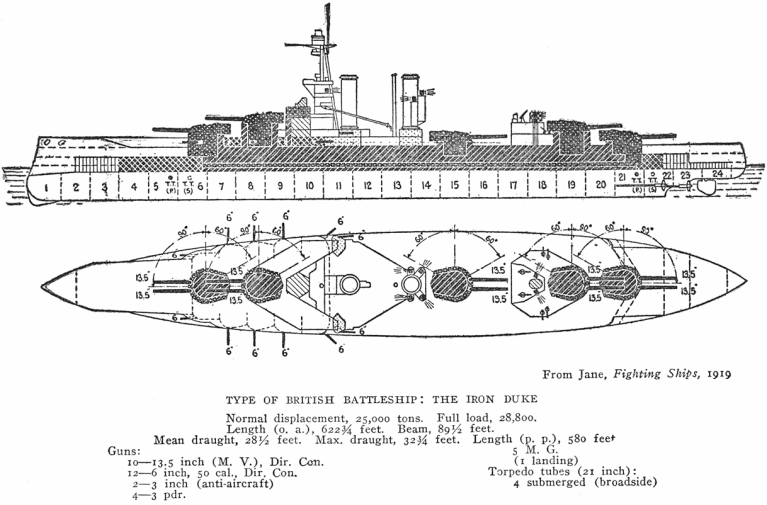
The main opponent of the decision, Admiral Fischer resigned as First Sea Lord in 1910. Since then, a new spiral has spun into stories with a caliber of 6 “on ships of the linear fleet.
In fact, the race was started at the suggestion of other famous dreadnought builders.
In 1909, the Nassau was launched in Germany. Qualitative, but too banal answer to the "Dreadnought". The Germans were unable to provide superiority in terms of speed, security, or the value of the main caliber. Instead, it turned out to be shocking. The scheme is "only big guns" while maintaining ... a six-inch medium caliber.
For all the fantasies and debates within the walls of the admiralty, the sailors paid with their lives.
The crews of anti-mine guns clearly took their places according to the combat schedule, waiting for the shells of the "six-inch" guns to reach the enemy. On that day, a pair of large-caliber shells pierced the side armor of the battleship Malaya and exploded on the battery deck. Dozens of sailors died from the detonation of the 152-mm guns. König and Tiger (the Jutland naval battle) suffered in a similar way.
At the beginning of the century, the construction of dreadnoughts with 152-mm auxiliary caliber had at least some logical explanation. The line fleets felt threatened by the growing destroyers and new torpedoes with increased cruising range.
But the presence of "double medium caliber" on many battleships built in 1920-1940 is even more surprising.
The following seems to be one of the sources of problems.
The main caliber of battleships has always been distinguished by the highest level of protection.
Thick walls of towers, powerful barbets and elevators for ammunition supply going deep down, almost to the very bottom. The cellars located in that area covered belts, armored decks and traverse bulkheads. The enemy needed to break through the maximum number of obstacles in order to get to the main battery ammunition. All design reserves were aimed at preventing such situations.
The rest of the armament of the battleships could not have such protection. First of all, for such quirks, there would not be enough displacement stock.
The frivolous attitude towards medium-caliber protection did not negate the fact that the SK ammunition could explode like an adult.
The public may be outraged by the author's harsh remarks and his subsequent conclusions. But before us are clear facts.
Acquaintance with the well-known projects surprises with what disdain their creators treated the defense of the towers and cellars of the UK. The most severe imbalance was found in the Yamato battleships, where the main caliber turrets had wall thickness from 250 to 650 mm. And the protection of medium-caliber turrets from the back and sides was provided by 25-mm walls with heat-insulating lining.
Japanese designers attached importance to the smallest details, but did not seem to notice the danger from gun turrets, whose walls could be broken by a shrapnel or torn to shreds by an explosion aviation bombs. Behind the walls, on trays and lifts, there were fragile charges containing tens of kilograms of gunpowder. And the mine, which opens a direct path to the ammunition storage, which was located next to the main caliber cellars!
The "cardboard" towers are believed to be the legacy of the Mogami cruisers. This fact corresponds to the chronology: in 1939-1940, four Mogami-class cruisers were re-equipped with towers with 203-mm cannons. The remaining installations with 155/60 Type 3 guns were later found everywhere - from naval arsenals to coastal batteries and Oyodo light cruisers. On the other hand, the sources do not comment on the differences in the design of the turrets of the SC cruisers and battleships. The latter were distinguished by increased front armor, reaching 75 mm.
In any case, such medium-caliber protection on one of the most protected ships in history looked ridiculous.
The SC of battleships of the "Nelson" type looked no less strange. 406-mm frontal plates and 350-mm barbets at the turrets of the main caliber. Again, the 25mm turret walls of the 6-inch guns.
Nelson, of course, has its own excuses. The world's first "negotiated battleship" project. Its creators chose the best possible. The preference fell on the all-or-nothing scheme along with the unusual arrangement of the main battery towers. The medium-caliber turrets were left in the stern, where no one cared about them.
But still...
We are talking about closely grouped weapons (2x6 caliber 152 mm) and tens of tons of explosives. In the absence of any protection for the rotary part of the towers and ammunition supply systems.
British designers have made titanic efforts to ensure the protection of all elements of the citadel. 356 mm conning tower walls and chimney protection made of 229 mm thick slabs. However, the medium caliber received no attention. As if the threat of detonation of 20 tons of gunpowder in the stern could be considered sheer nonsense, incapable of influencing the actions of the battleship in combat conditions.
This is a real paradox.
The creators of "Nelson" and "Yamato" were well aware of the issues of ship security. Much better than you and me. And if they did this with the SK towers, it means that there really was no threat.
On the other hand, how to explain the design of 152 mm installations on the Italian Littorio, where the frontal part reached 280 mm, and the turret roof was protected by 100-150 mm thick armor?
The Genoese craftsmen suspected some kind of danger and desperately tried to protect the ship from it. As far as possible.
As for the ships described at the beginning of the article, the French aircraft of the "Richelieu" type received three aft anti-mine turrets each. With wall thickness from 70 to 130 mm.
Is it necessary to clarify that the achieved values were several times inferior to the indicators of the security of the GC?
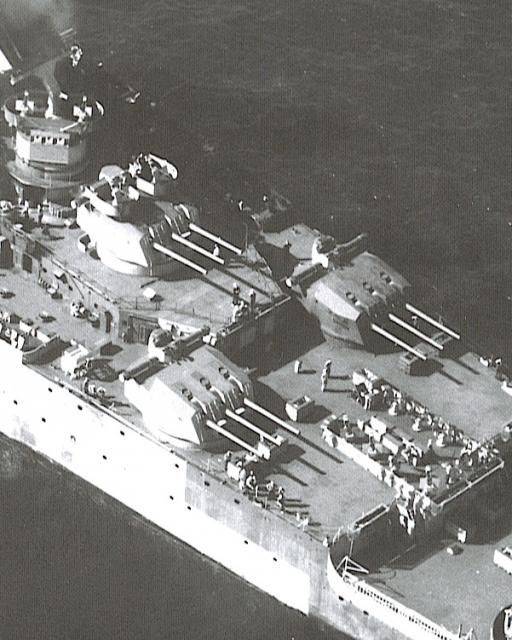
Certain indulgences were also observed in the design of the cellars.
The floor of the fighting compartment of the secondary battery tower was almost half the thickness (30 versus 55 mm for the main battery turret). It is possible to note the smaller thickness of the main armored deck above the secondary battery cellars (150 instead of 170 mm at the bow group of the main battery towers). Or a smaller aft traverse, where there was no additional protection in the gap between the main and lower splinterproof decks.
Each element of the battleship had its own priority.
The failure of the secondary battery turret could not have such an impact on combat effectiveness as the loss of the main caliber turret. And in general, no one was going to book the entire ship according to the standards for the main battery towers.
For example, a medium caliber relied on a high targeting speed, which in itself excluded the presence of heavy protection.
And the 100-mm anti-aircraft guns of the "Richelieu" battleships had no armor at all, with the exception of a 30 mm thick frontal shield. The designers sought to provide the largest number of firing points and high mobility of anti-aircraft guns.
Anti-aircraft weapons, at least, tried to solve their problems. And it was regularly used in battle.
For 6-inch artillery, the claim is as follows: what was the justification for finding such weapons on board battleship-class ships in 1920-1940?
The PMK was impossible to really protect. Among the auxiliary weapons, the PMK posed the greatest threats. At the same time, assessments of its combat value were in doubt.
Six inches was clearly overkill for auxiliary tasks.
For unknown reasons, the designers often forgot about the fire controls for the 6-inch guns. Which turned these magnificent cannons into pieces of silent metal.
Insufficient elevation angles and low rate of fire made it impossible to fire at air targets.
The location of the secondary battery artillery on the "Nelson" and "Richelieu" gives out the designers' intention - to provide cover for the dead zone of the main battery.
The main caliber artillery of the "Nelson" and "Richelieu" fired ammunition, which weighed under 900 kg. 6-inch shells were 15 times lighter.
Questions arise.
How could 6-inch fire replace the main caliber? And how they defended themselves from destroyers at the bow corners, outside the range of the secondary battery:
In the case of the Richelieu, firepower at the aft corners was provided by unprecedentedly large swivel angles of the main caliber turrets (over 300 degrees). And also due to the mobility and maneuverability of the artillery platform itself, that is, the ship.
The use of six-inch guns in repelling attacks from light surface forces was devalued by the presence of large-caliber anti-aircraft guns. With a high rate of fire and high-speed guidance drives. In fact, we are talking about a universal caliber with its accepted value of about 5 inches. In different fleets, there was a variation of ± 0,3 inches.
Taking these factors into account, 6-inches became the Achilles heel of battleships. As the experience of both world wars has shown, secondary battery guns, due to various circumstances, were practically never used for their intended purpose. And all attempts to give them universality or use for other tasks have failed.
Dangerous "ballast"!
In absolute terms, the damage was expressed in tens of tons of explosives that were just on board, always ready to detonate when the cellars were hit.
French sailors were fabulously lucky in Casablanca. But the biggest casualty of its own mine-action caliber was probably the battleship Roma. One of the guided German bombs hit the ammunition cellar of 152-mm guns (hit number 2 in the diagram).
From the standpoint of the distribution of load items, a battery of 6-inch guns demanded simply colossal costs, incommensurate with the usefulness of the guns themselves. The installation of even unarmored towers and the arrangement of storage sites for ammunition took thousands of tons of hull structures, which could be used to improve other characteristics of ships.
Finale
It is easy to draw conclusions after the results of the battles have become known. And time put everything in its place.
On the other hand, what amateurs are now talking about was previously done by professionals.
Individuals whose job responsibilities included a thorough study and analysis of the situation, the upcoming tasks and parameters of the weapon worked on the design of the technical task. The specialists had the most important and secret information at their disposal. Test reports, ship damage atlases, tactical guides and artillery tables. In that case, they should have known as much as we do now.
The logic behind the choice of weakly defended secondary battery turrets and the very presence of a double medium caliber on late battleships remains unclear.
The second reason is a whole galaxy of ships, the creators of which avoided 152-mm artillery. Overseas, the designers initially opted for a 5-inch (127 mm) caliber. Gradually increasing the number of installations, as the size of the battleships themselves increases. Subsequently, this practice led to the equipping of "battle ships" with very successful universal weapons 5 "/ 38, with which the Yankees went through the entire war.
The British followed the example with the creation of their "King George V" (1939), the auxiliary armament of which consisted of 16 universal 133 mm guns. Here, it will be appropriate to recall the battlecruisers of the "Rhinaun" class with a 4-inch medium caliber.
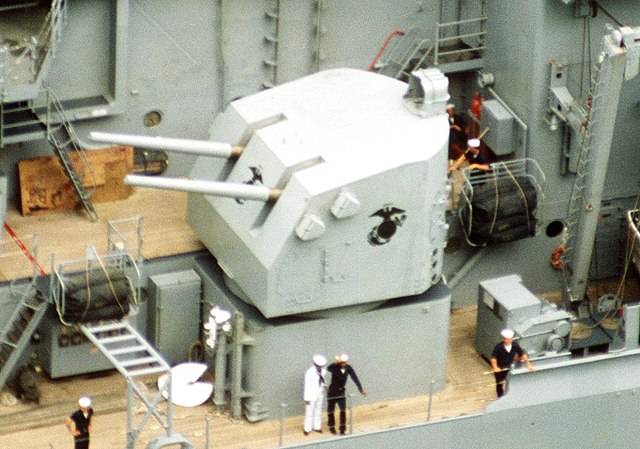
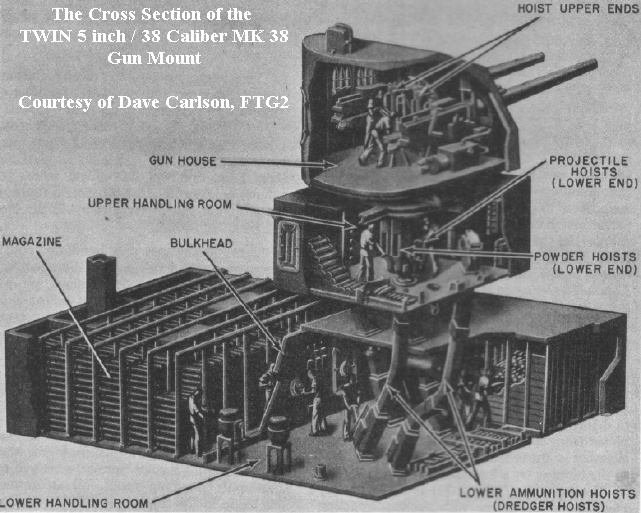
Even the Japanese, in the end, were forced to revise the composition of the Yamato's weapons. They managed to dismantle a couple of turrets with 155-mm guns from the lead ship, replacing them with universal 127-mm cannons (Type 89) and small-caliber anti-aircraft guns.
Finally, in order to avoid unfounded remarks, I will emphasize the main idea of the article.
If a weapon is present on board, but not used in combat situations, its unused ammunition becomes a source of senseless risks and problems. In this form, the "weapon" poses a greater danger to the ship itself than to the enemy. This situation itself raises questions.
Is the above said in relation to the anti-mine caliber of battleships?
It will be interesting to know the opinion of the readers of "Military Review" about this ...
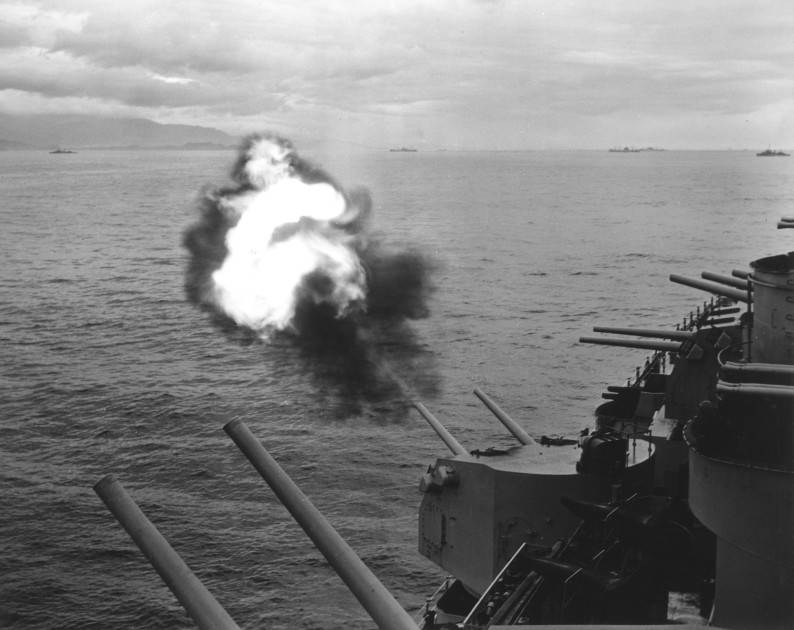
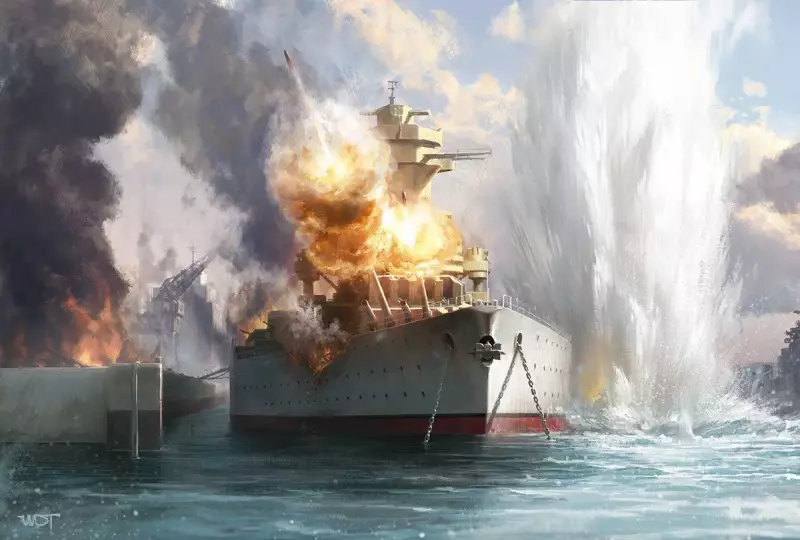
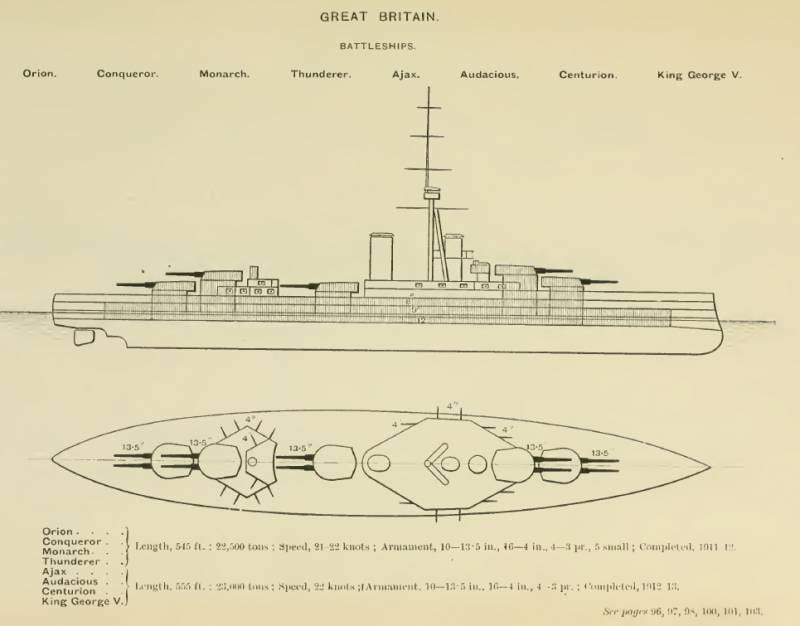
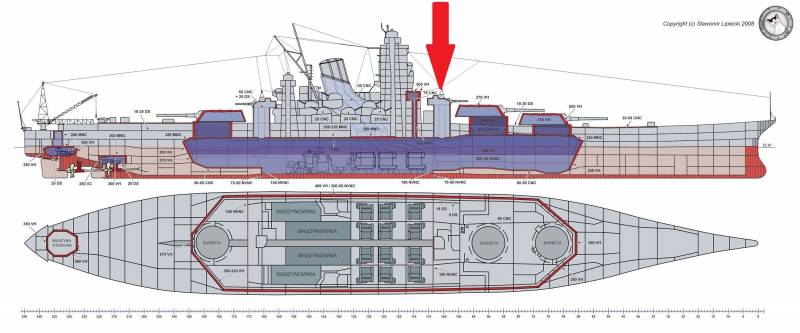
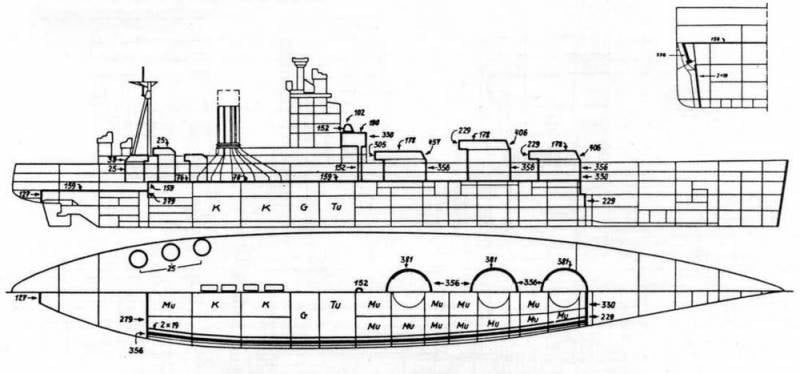

Information